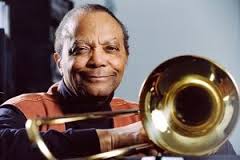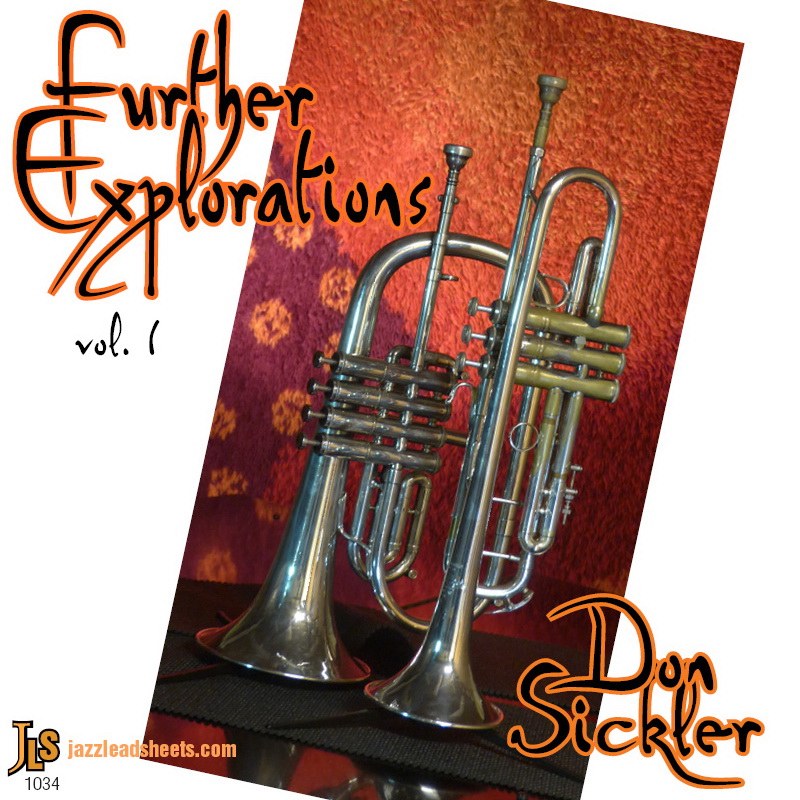Why Indianapolis, Why Not Indianapolis? – J.J. Johnson
This simple song is a good educational tool for modal playing. We have a "Further Explorations" recording with Minus You for all instruments to play along with, along with a solo from Don Sickler. For the quintet arrangement from the original recording, a full score and parts are available.
- Recording: J.J. Johnson - Quintergy
- Recorded on: July 9-10, 1988
- Label: Antilles (422-848214)
- Concert Key: D minor
- Vocal Range: , to
- Style: Swing (medium up)
- Trombone - J. J. Johnson
- Tenor Sax - Ralph Moore
- Piano - Stanley Cowell
- Bass - Rufus Reid
- Drums - Victor Lewis
- Description
- Historical Notes
- Solos
- Piano Corner
- Bass Corner
- Drum Corner
- Guitar Corner
- Inside & Beyond
- Minus You
About the arrangement: Full score and parts are available for the recorded quintet arrangement, which is quite spare but clever in the classic J.J. Johnson style. The first A section is played by the rhythm section alone; the second A adds tenor sax trills. The trombone joins the tenor for B, and C starts with trombone and rhythm section for four measures followed by four with just the rhythm section. After solos, instead of playing the entire melody out, the rhythm section vamps and fades on the A section figure. The tenor comes in with trills again in the second eight measures of this vamp. Starting in the third eight measures, the horns improvise together over the vamp until a final cue of two fermatas: a G7 chord and a unison G.
On this recording, J. J. begins with a cadenza, setting up the rhythm section with eight measures of the D minor ostinato which is where our audio excerpt starts.
Our drum part shows a simple groove, with cross stick on beat 4 of the second measure in each two-measure phrase. On the recording, Victor Lewis plays a more active pattern; we indicate "time with optional fills." In addition to the piano, bass and drum parts, we have a guitar rhythm section part; the single-line A section figures work well with guitar instead of piano.
Related Songs
Email Send Why Indianapolis, Why Not Indianapolis? to a friend
- Recording: Don Sickler - Further Explorations Vol. 1
- Recorded on: April 14, 2002
- Label: jazzleadsheets.com (JLS 1034)
- Concert Key: D minor
- Vocal Range: , to
- Style: Swing (medium up)
- Trumpet, Flugelhorn - Don Sickler
- Tenor Sax - Mark Lopeman
- Piano - Cecilia Coleman
- Bass - Tim Givens
- Drums - Vince Cherico
Video
- Description
- Historical Notes
- Solos
- Piano Corner
- Bass Corner
- Drum Corner
- Guitar Corner
- Inside & Beyond
- Minus You
This is a quintet recording, keeping the two-horn arrangement on the head though there is only one minus melody track. When playing with this track, the first part rests for the two A sections (A1 rhythm section alone, A2 adding tenor sax trills) and come in on the melody at B with the tenor. The melody continues into the first four measures of C.
There are trumpet and tenor sax backgrounds on the bridge of the 3rd and 6th solo choruses, as well as a line in the last measure of the 3rd chorus that sets up the tenor solo. These backgrounds are included in all parts. The solo form shows multiple endings, reflecting what happens at the end of all six solo choruses.
The vamp out is 32 measures long, followed by the last two fermatas. The first eight measures are rhythm section alone, while the tenor comes in with trills for the following 16 measures. On the full track the flugelhorn solos over the vamp starting when the tenor comes in and continuing until the fermatas; if you're playing with the minus melody track you could also start soloing at the beginning of the vamp.
Click on Minus You for more details. For Don Sickler's flugelhorn solo, click on Solos.
-- intro
-- melody
-- 3 choruses flugelhorn solo
-- 3 choruses tenor sax solo
-- out vamp:
There are two versions of the minus melody track. Our practice edition is the same length as the other tracks, with the soloist taken out so you have six choruses to solo. We also have a performance edition with three solo choruses; if you're playing with this track you skip the 1st, 2nd and 3rd endings and take the 4th, 5th and 6th endings.
mp3 minus Melody
- the tenor sax 2nd part is still included on the head and out vamp
-- count off sets up the intro
-- play the intro (with piano) and melody
-- practice edition: solo 6 choruses (backgrounds on the 3rd and 6th choruses)
-- solo on the vamp out (after 8 measures); play the last two fermatas
-- performance edition: solo 3 choruses (backgrounds on the 3rd chorus)
mp3 minus Piano
-- count off sets up the intro (rest)
-- play the melody chorus
-- comp/play figures for the flugelhorn solo (3 choruses) and tenor sax solo (3 choruses)
-- play the vamp out
mp3 minus Bass
-- count off sets up the intro (rest)
-- play the melody chorus
-- walk/play figures for the flugelhorn solo (3 choruses) and tenor sax solo (3 choruses)
-- play the vamp out
mp3 minus Drums
-- count off sets up the intro (rest)
-- comp/play figures for the melody
-- comp/play figures for the flugelhorn solo (3 choruses) and tenor sax solo (3 choruses)
-- comp for the vamp out
Related Songs
Email Send Why Indianapolis, Why Not Indianapolis? to a friend

J.J. Johnson
January 22, 1924 – February 4, 2001
J.J. Johnson is arguably the most influential bop and post-swing trombonist and also one of the great composers and arrangers in jazz. He was one of the first trombonists to embrace bebop; his playing continues to exert a strong influence on other musicians. He started his recording career in 1942 in Benny Carter's big band. On July 2, 1944, J.J was on the first Jazz At The Philharmonic concert. He recorded with the Count Basie Orchestra beginning in 1945. Read more...




